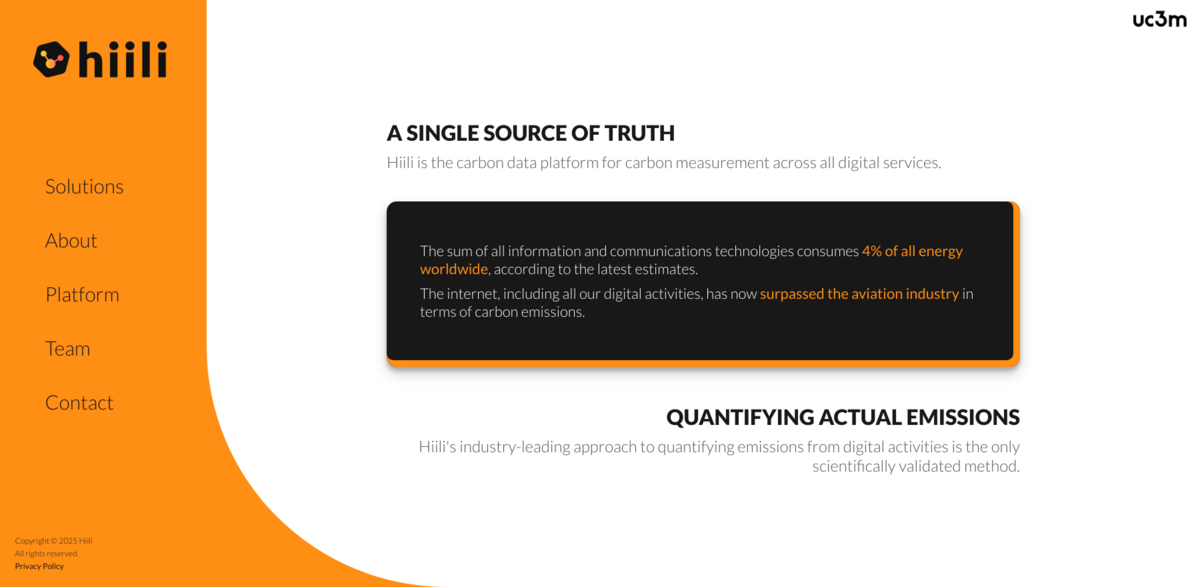What is Hiili?
Hiili is the carbon data platform designed specifically for measuring carbon emissions across all digital services. You might not realize it, but the sum of all information and communications technologies gobbles up about 4% of all the energy worldwide. And get this—the internet, with all our digital activities combined, has now overtaken the aviation industry when it comes to carbon emissions. That’s a big deal.
The Main Benefit of Hiili
Hiili offers an industry-leading, scientifically validated approach to quantifying emissions from digital activities. It’s not just another tool—it’s the only method backed by science that delivers unrivaled accuracy. Here’s what makes Hiili stand out:
- Implement a simple pixel across all your media campaigns for precise carbon measurement
- Gather granular, anonymized data to keep your reporting simple and secure
- Get a real overview of emissions and energy consumption from AI services and products
- Easily connect ad servers, DSPs, ChatGPT, social media accounts, and more
- Export or automate CO₂ and efficiency numbers per activity, campaign, or brand
- Receive a Hiili grade for every activity and campaign, benchmarked against industry standards
The Science Behind Hiili
Hiili’s approach isn’t just guesswork. It’s the only scientifically validated method out there for measuring digital carbon emissions. This means the data you get is reliable, accurate, and actionable. The platform’s pixel technology collects detailed, anonymized data, ensuring privacy while giving you the numbers you need to make informed decisions. It’s a game changer for anyone serious about sustainability in the digital space.
Origins and Development
Hiili is a joint venture between Universidad Carlos III de Madrid and seasoned veterans from the media and advertising industries. Since 2018, its research has been featured and quoted in countless outlets and newspapers, proving its credibility and impact. In 2024, Hiili officially launched as a spin-off venture, aiming to take its first-generation carbon data platform to the next level. This evolution marks a new chapter in digital carbon measurement.
How Hiili Works in Practice
Connecting your digital tools to Hiili is straightforward. Whether it’s your ad server, demand-side platform (DSP), ChatGPT, or social media accounts, Hiili integrates seamlessly to provide a complete overview of your digital carbon footprint. This holistic view helps identify where emissions are highest and offers methods for optimization. Plus, the platform’s ability to export or automate CO₂ and efficiency metrics makes reporting easier than ever.
Hiili’s Impact on Sustainable Development Goals (SDGs)
- SDG 7: Affordable and Clean Energy – by promoting energy-efficient digital services
- SDG 9: Industry, Innovation, and Infrastructure – through innovative carbon measurement technology
- SDG 12: Responsible Consumption and Production – by enabling transparent carbon reporting
- SDG 13: Climate Action – supporting efforts to reduce carbon emissions in the digital sector
Why Digital Carbon Measurement Matters
With digital activities now surpassing aviation in carbon emissions, understanding and managing this footprint is crucial. Hiili offers a clear, accurate, and practical way to do just that. It empowers businesses and organizations to take responsibility for their digital carbon impact and make smarter, greener choices. In a world where every bit of data counts, Hiili shines a light on the unseen energy costs behind our online lives.





















